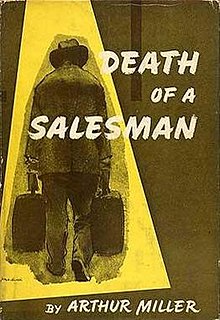
Back موت بائع متجول (مسرحية) Arabic La mort d'un viatjant (teatre) Catalan Smrt obchodního cestujícího Czech Diwedd Dyn Bach Welsh En sælgers død Danish Tod eines Handlungsreisenden German Ο Θάνατος του Εμποράκου Greek Muerte de un viajante Spanish مرگ فروشنده Persian Kauppamatkustajan kuolema Finnish
| Death of a Salesman | |
|---|---|
 First edition cover (Viking Press) | |
| Written by | Arthur Miller |
| Characters | Willy Loman Linda Loman Biff Loman Happy Loman Ben Loman Bernard Charley The Woman Howard |
| Date premiered | February 10, 1949 |
| Place premiered | Morosco Theatre New York City |
| Original language | English |
| Subject | The waning days of a failing salesman |
| Genre | Tragedy |
| Setting | Late 1940s; Willy Loman's house; New York City and Barnaby River; Boston |
Death of a Salesman is a 1949 stage play written by the American playwright Arthur Miller. The play premiered on Broadway in February 1949, running for 742 performances. It is a two-act tragedy set in late 1940s Brooklyn told through a montage of memories, dreams, and arguments of the protagonist Willy Loman, a travelling salesman who is despondent with his life and appears to be slipping into senility. The play addresses a variety of themes, such as the American Dream, the anatomy of truth, and infidelity.[1][2] It won the 1949 Pulitzer Prize for Drama and Tony Award for Best Play. It is considered by some critics to be one of the greatest plays of the 20th century.[3] The play was selected as one of the best plays of 1948–1949, with an excerpted version published in The Burns Mantle Best Plays of 1948–1949.[4]
Since its premiere, the play has been revived on Broadway five times,[5] winning three Tony Awards for Best Revival. It has been adapted for the cinema on ten occasions, including a 1951 version by screenwriter Stanley Roberts, starring Fredric March. In 1999, New Yorker drama critic John Lahr said that with 11 million copies sold, it was "probably the most successful modern play ever published."[6]
- ^ "Synopsis: Death of a Salesman". Utah Shakespeare Festival. Retrieved November 23, 2020.
- ^ "Death of a Salesman: Death of a Salesman Play Summary & Study Guide | CliffsNotes". www.cliffsnotes.com. Retrieved November 23, 2020.
- ^ "Death of a Salesman". www.therep.org. Archived from the original on February 5, 2017.
- ^ Chapman, John (ed.), The Burns Mantle Best Plays of 1948–1949, (1949) Dodd, Mead and Company, New York, pp. 53–87.
- ^ "Death of a Salesman". ibdb.com. Retrieved October 10, 2022.
- ^ Lahr, John (January 18, 1999). "Arthur Miller and the Making of Willy Loman". The New Yorker. Retrieved October 29, 2022.